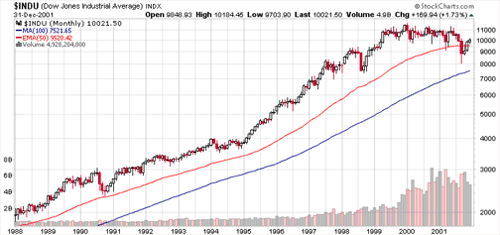The Meteoric History
of Online Stock Trading
SPONSOR:
The trend is your friend! Click here to see the Top 50 Trending Stocks.

The history of online stock trading is a fascinating and revolutionary story about the power of two worlds colliding and changing the industry of stock trading forever. The two that were destined to meet? Public access internet service and electronic stock trading.
It’s hard to remember it now, but prior to the combination of the two, investors used to call (via land lines only at the time) a live broker (real person) to place a trade. Similarly, stock brokers used to call investors and “sell” the purchase of a company’s stock. Now with a few keystrokes and a click, an investor can access information and initiate a stock trade with no assistance or advice.
In the Beginning
As early as 1969, digital trading systems called electronic communications networks (ECNs) were being used by brokerages to display in-house the bid and ask prices for stocks. By the late 1980s, as the financial industry began to realize the potential of a public internet and ownership of personal computers was growing in popularity, some of the leading brokerages began to look more closely at ECNs. Several industrious brokerages either developed software or bought companies that had developed software to link up stock traders with current stock price information, thereby matching up buyers with sellers easily and efficiently and with significant cost savings.
I remember the first time I saw a computer with its black screen background and green type. It was 1981 at my local Radio Shack. But just one year later in 1982, the first full service electronic consumer equity trading system for buying and selling stocks, mutual funds and commodities using a PC came online. It was called NAICO-NET and it was offered by a company called North American Holding Corp. located in East Hartford, CT. The system was ANSI based, meaning it was terminal based but IBM PCs could connect to it via a simple application and it connected traders from all over the world. Trades were sent directly to Pershing Corp. (Donaldson Lufkin & Jenrette) for high speed clearing and the trader subscription base quickly rose to over 5,000. And the rest, as they say, is history – the history of online stock trading.
Over the next 10 years, the history of online stock trading developed slowly, temporarily crippled by the stock market crash of 1987, a recession and the Gulf War. Additionally, the costs were still generally high for online access for retail stock traders. It was in the 1990s that things shifted and online stock trading really took off.
Trade*Plus was another pioneering company in the history of online stock trading and in 1985 offered some of the very first retail trading platforms on America Online and Compuserve. Trade*Plus continued to offer its services to brokerages, but in 1991 one of the founders of Trade*Plus, William Porter, created a new subsidiary company called E*Trade Securities, Inc.
For retail traders, the coming together of better accessibility to information, the ease of an electronic trade and decreased cost to process a trade enhanced the popularity of online stock trading and it began to take off. By the mid-1990s, more than 20 percent of the nation’s population was investing in stock, compared with less than 5 percent the decade before. To illustrate the impact this had on E*Trades’ bottom line, its revenues increased from $850,000 in 1992 to $11 million in 1994 and was rated as the fastest growing company in America that year. The rush to become an online stock trading broker was on!
Another well-known company, TD Ameritrade, originally started out as a company called First Omaha Securities and in 1995 the company acquired K. Aufhauser & Company, Inc. and its WealthWeb, which had begun offering online stock trading in August 1994. The company that was to eventually become TD Ameritrade continued to merge and acquire other companies, quickly becoming one of the largest online brokerages.
A conversation about the history of online stock trading must include the fact that Charles Schwab, for a long time, had been cornering a huge portion of the financial industry’s market share through branch offices and discount fees. They continued to build market share at a strong pace all through the 1990s. Charles Schwab was only slightly late to the online stock trading party and became another strong leader as an online stock trading provider in the late 1990s, combining their market share with strong promotional activity. They started by providing a web presence in 1995 and at the time had $181.7 billion in total client assets. The very next year their online stock trading went live and in 1996, they ended the year with $253 billion in total client assets. By the next year, 1997, Charles Schwab registered it’s one millionth online account, reached total client assets of $437 billion and ranked as the top online broker in the U.S.
Joining the party, Scottrade.com launched in 1996 and turned the heat up in 1998 with online trades beginning with a low commission rate of $7 per trade.
The Frenzy!
The ease of online trading for the retail trader and discounted commission fees made online trading more attractive to more people. An advisory group reported that the number of online brokerages jumped from 12 in 1994 to more than 140 by the end of 2000.
Additionally, the ease and popularity of online stock trading opened up a whole new career in the financial industry – day traders to whom many analysts attribute the market volatility of the late 1990s.
This steady and continual influx of cash into the stock exchanges during the 1990s helped to create a very strong bull run as you can see in the monthly chart (1988 through 2001) of the Dow Jones Industrial Average ($INDU) below:

As impressive as the upward climb in value was, look also at the incredible rise in volume. This chart helps to tell the story of the history of online stock trading. The frenzy that easy access and a bull market inspired only helped to perpetuate the upward run that eventually wouldn’t be able to sustain itself with the same strength.
A larger aspect of the history of online stock trading is the way that stock trading has changed from proprietary, broker-driven trading to open-access, consumer-driven trading. That shift has left some potholes in individual trader’s ability to be successful with trading. We, as retail investors have better access – but many have ineffective investment knowledge. Many consumers need to match up greater investment knowledge with the incredible access to be truly successful investors.
The Future of Online Stock Trading
As for the future of online stock trading, it will continue to evolve in several areas. Expect to see more development of streamlined software applications for trading. For example, many brokerages now offer trading applications (apps.) for cell phones that have mobile web browser capabilities. The mobile trading services provide basically the same services as those that investors access now using their personal computers. Look for brokerages to continue to broaden stock trading capabilities for retail traders.
The future also holds greater access to many different investing products and expanding markets. For example, continued access to a wide range of investing vehicles like mutual funds, ETFs, options, forex as well as an expanding group of products and greater access to trading in global markets.
And lastly, because the history of online stock trading has developed so quickly, a stronger, knowledge-based approach for investors that expands beyond the traditional “buy and hold” strategy or day trading is vital. Most online investment brokerages are beginning to offer enhanced educational programs because they understand that the more successful stock trading is for investors, the better opportunity online brokerages have to increase their business.
A knowledge-based, solid approach is the future of online stock trading for investors and that’s what you’ll find here at Stock-Trading-Warrior.com.
For an overview of a solid stock trading system go to
Stock Trading Systems.
Interested in looking at a
stock market historical graph of the Dow Jones Industrial Average ($INDU)? Click here!
Return from
History of Online Stock Trading to Online Stock Trading Warrior Home.






